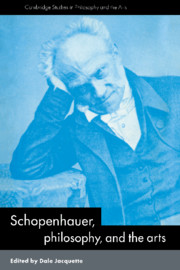Book contents
- Frontmatter
- Contents
- List of contributors
- Editor's acknowledgments
- List of abbreviations
- 1 Schopenhauer's metaphysics of appearance and Will in the philosophy of art
- PART I The work of art: Schopenhauer on the nature of artistic creation
- PART II The experience of beauty: Schopenhauer's theory of aesthetic encounter
- 5 Pleasure and knowledge in Schopenhauer's aesthetics
- 6 Schopenhauer and aesthetic recognition
- 7 Schopenhauer on beauty and ontology
- 8 Schopenhauer, Heidegger, art, and the will
- PART III Schopenhauer's enduring influence on the arts: idealism and romanticism
- Bibliography of selected sources on Schopenhauer's aesthetics
- Index
6 - Schopenhauer and aesthetic recognition
Published online by Cambridge University Press: 05 May 2010
- Frontmatter
- Contents
- List of contributors
- Editor's acknowledgments
- List of abbreviations
- 1 Schopenhauer's metaphysics of appearance and Will in the philosophy of art
- PART I The work of art: Schopenhauer on the nature of artistic creation
- PART II The experience of beauty: Schopenhauer's theory of aesthetic encounter
- 5 Pleasure and knowledge in Schopenhauer's aesthetics
- 6 Schopenhauer and aesthetic recognition
- 7 Schopenhauer on beauty and ontology
- 8 Schopenhauer, Heidegger, art, and the will
- PART III Schopenhauer's enduring influence on the arts: idealism and romanticism
- Bibliography of selected sources on Schopenhauer's aesthetics
- Index
Summary
INTRODUCTION
Nature and art exist on an aesthetic continuum for Schopenhauer, but one that splinters, much like the straws of a broom, along subtly different trajectories. As with straw tethered to a broom handle, artworks find their anchor in nature, fastened to it by the vision and imagination of genius. In what follows it is suggested that Schopenhauer's philosophy of art grows out of his views on our aesthetic engagement with and general indebtedness to the natural world. This reading of Schopenhauer poses an intriguing challenge to category-relative and institutional theories of art, where history, criticism and convention determine the framework for accurate aesthetic assessment. Before considering this challenge, however, the approach here taken to Schopenhauer's aesthetics requires justification and clarification: justification of its disregard for questions concerning the aesthetic function of metaphysical Ideas and clarification of the relationship between nature and works of art, mediated as they are by the natural capacities of artistic genius.
EXCLUDING IDEAS
Because Schopenhauer's aesthetic observations are sandwiched between and imbued with the details of his metaphysical system, we tend to interpret his views on art, beauty and genius exclusively through the filter of that system. Indeed, Schopenhauer presents his aesthetic theory as a companion to his metaphysical view of the world and indeed promotes it as one of two avenues of salvation from the tumult of Will, the author of our earthly predicament. Yet, much of Schopenhauer's theory strikes us as being at odds with itself. Sometimes he seems to favor art as being the quickest route to attaining pure subjectivity, while at other times he privileges nature for the same task.
- Type
- Chapter
- Information
- Schopenhauer, Philosophy and the Arts , pp. 133 - 149Publisher: Cambridge University PressPrint publication year: 1996

